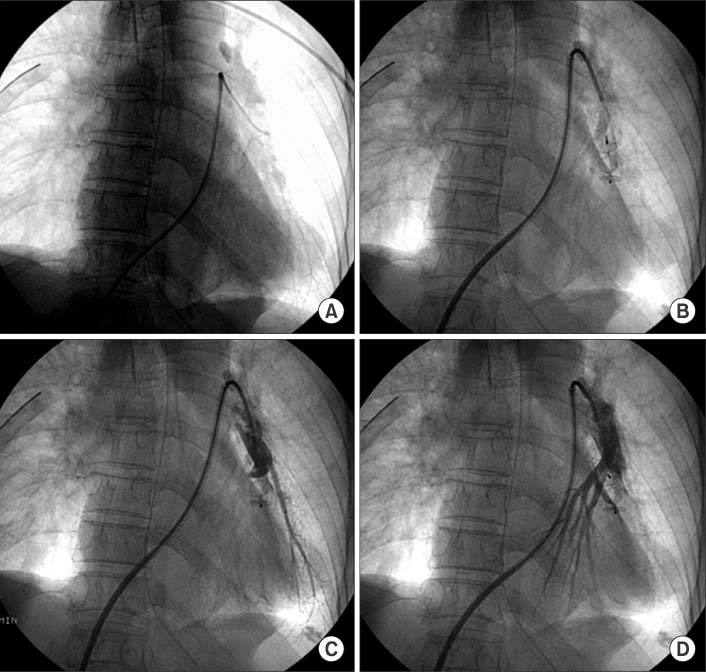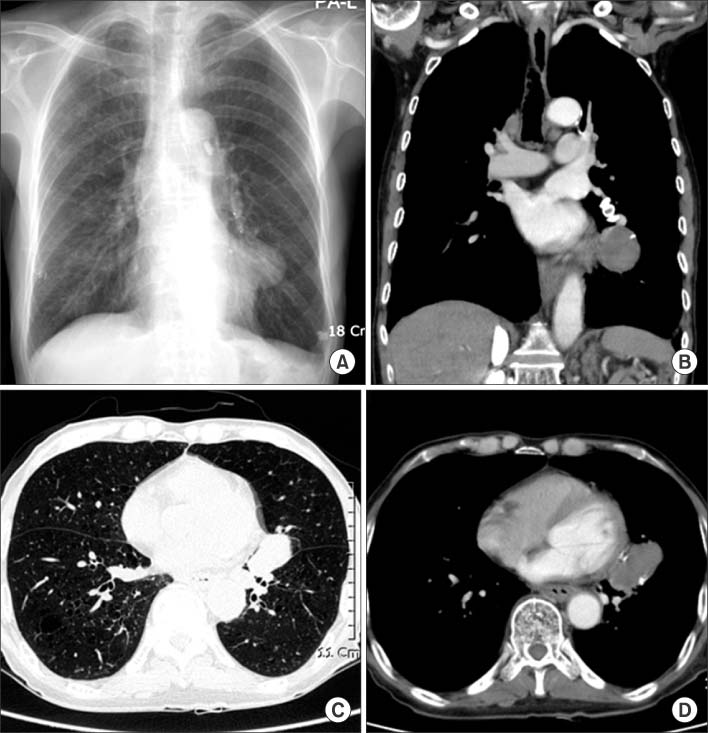Tuberc Respir Dis.
2009 Jul;67(1):52-58.
Transcatheter Embolotherapy of Giant Pulmonary Arteriovenous Malformation Using Amplatzer(R) Vascular Plug
- Affiliations
-
- 1Department of Internal Medicine, Korea University College of Medicine, Ansan Hospital, Ansan, Korea. chepraxis@korea.ac.kr
- 2Department of Radiology, Korea University College of Medicine, Ansan Hospital, Ansan, Korea.
Abstract
- Pulmonary arteriovenous malformation (PAVM) is a rare pulmonary vascular anomaly due to an abnormal communication between the pulmonary artery and vein. The most common presenting symptom is a dyspnea on exertion related to this right-to-left shunt. If left untreated, PAVM has been known to result in serious complications. Incomplete pulmonary capillary network can be the cause of cerebral abscesses and other non-infectious neurological complications, such as stroke and transient ischemic attacks due to paradoxic embolism Transcatheter embolotherapy, using coils or balloons, has replaced surgical resection as the treatment of choice for PAVM. However, the risk of device embolization has limited the use of coil embolotherapy, while the size of PAVM is huge. Recently, Amplatzer(R) Vascular Plug has been proposed as an alternative endovascular occlusion device for arteriovenous malformation. We report a case of 81-year-old male patient with a giant PAVM, which was successfully treated by transcatheter embolotherapy using the Amplatzer(R) Vascular Plug.
MeSH Terms
Figure
Reference
-
1. Gossage JR, Kanj G. Pulmonary arteriovenous malformations: a state of the art review. Am J Respir Crit Care Med. 1998. 158:643–661.2. Loke GP, Story DA, Liskaser F, Seevanayagam S. Pulmonary arteriovenous malformation causing massive haemoptysis and complicated by coronary air embolism. Anaesth Intensive Care. 2006. 34:75–78.3. Khurshid I, Downie GH. Pulmonary arteriovenous malformation. Postgrad Med J. 2002. 78:191–197.4. Pierucci P, Murphy J, Henderson KJ, Chyun DA, White RI Jr. New definition and natural history of patients with diffuse pulmonary arteriovenous malformations: twenty-seven-year experience. Chest. 2008. 133:653–661.5. Jung JY, Lim JK, Chun SW, Suh WN, Kim DJ, Lee KH, et al. A case of video-assisted thoracoscopic pneumonectomy for unilateral diffuse pulmonary arteriovenous malformation. Tuberc Respir Dis. 2006. 61:585–590.6. Kim MD, Kim JS, Lim CY. Treatment of pulmonary arteriovenous malformation using platinum coils: case report. J Korean Radiol Soc. 2005. 52:113–116.7. Han YM, Song HY, Lee JM, Chung JY, Lee SY, Chung GH, et al. Pulmonary arteriovenous malformation treatment with detachable balloon: a case report. J Korean Radiol Soc. 1996. 34:595–598.8. Luthra S, Antippa P, Tatoulis J. Pulmonary arteriovenous aneurysm as manifestation of Osler-Weber-Rendu syndrome. Heart Lung Circ. 2008. 17:336–339.9. Gezer S, Turut H, Oz G, Demirag F, Tastepe I. Acquired pulmonary arteriovenous malformation secondary to hydatid cyst operation. Thorac Cardiovasc Surg. 2007. 55:462–463.10. Kim CH, Kim TH, Park JB, Jeong JP, Ko YC, Lee SU, et al. A case of diffuse pulmonary arteriovenous malformation with multiple nodules on chest X-ray. Chonnam Med J. 2005. 41:233–236.11. Ones T, Dede F, Erdim R, Erdil TY, Inanir S, Yuksel M, et al. Quantitative shunt imaging in the evaluation of therapeutic surgery in a patient with pulmonary arteriovenous malformation. Ann Thorac Surg. 2008. 86:649–651.12. Cil B, Canyigit M, Ozkan OS, Pamuk GA, Dogan R. Bilateral multiple pulmonary arteriovenous malformations: endovascular treatment with the Amplatzer Vascular Plug. J Vasc Interv Radiol. 2006. 17:141–145.13. Hinterseer M, Becker A, Barth AS, Kozlik-Feldmann R, Wintersperger BJ, Behr J. Interventional embolization of a giant pulmonary arteriovenous malformation with right-left-shunt associated with hereditary hemorrhagic telangiectasia. Clin Res Cardiol. 2006. 95:174–178.14. Abdel Aal AK, Hamed MF, Biosca RF, Saddekni S, Raghuram K. Occlusion time for Amplatzer vascular plug in the management of pulmonary arteriovenous malformations. AJR Am J Roentgenol. 2009. 192:793–799.15. Kim JH, Park OS, Lee KW, Yun SH, Kang DG, Ko YC, et al. A case of embolotherapy of diffuse pulmonary arteriovenous malformation using Amplatzer Vascular Plugs. Chonnam Med J. 2006. 42:144–147.
- Full Text Links
- Actions
-
Cited
- CITED
-
- Close
- Share
- Similar articles
-
- A Case of Embolotherapy of Diffuse Pulmonary Arteriovenous Malformation Using Amplatzer Vascular Plugs
- Transcatheter Embolization of Giant Pulmonary Arteriovenous Malformation with an Amplatzer Vascular Plug II
- Hereditary Hemorrhagic Telangiectasia Combined with Pulmonary Arteriovenous Malformation Treated with Transcatheter Embolotherapy
- Transcatheter Occlusion of a Giant Pulmonary Arteriovenous Malformation in a 1-year-old Child Using Amplatzer Vascular Plugs and Interlocking Detachable Coils
- Coronary Artery Fistula Draining into Lung Parenchyma Causing Localized Pulmonary Edema: Transcatheter Closure with an Amplatzer Vascular Plug 4





